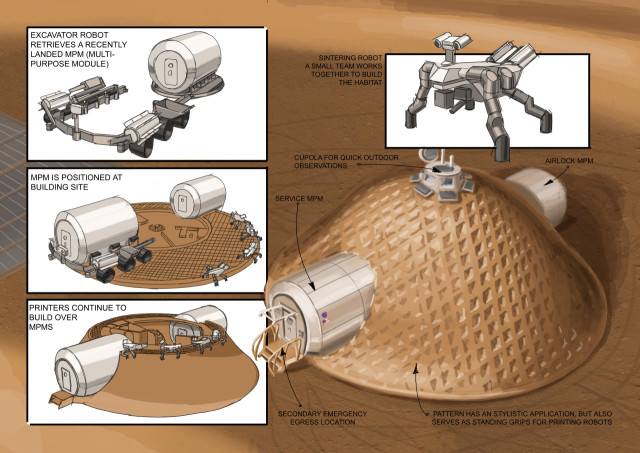MIT printed this fully functional robot right out of a 3D printer.
MIT printed this robot this fully functional robot right out of a 3D printer. http://voc.tv/14JQHoo
MIT printed this fully functional robot right out of a 3D printer.
MIT printed this robot this fully functional robot right out of a 3D printer. http://voc.tv/14JQHoo


Steve Jurvetson is a man of many facets – and he can 3D print a rocket that achieves Mach 1.8 (that’s 1,363 mph) in 2.6 seconds and reach an altitude of nearly 9,500 feet.
The Mach number is named after the Austrian physicist and philosopher, Ernst Mach. The terms “subsonic” and “supersonic” basically refer to speeds below and above the local speed of sound, so you should have some idea how fast these tiny rockets are traveling.
Jurvetson is a partner and managing director at Draper Fisher Jurvetson, a venture capital firm, and his board responsibilities include projects like SpaceX, Synthetic Genomics, and Tesla Motors. He was also a founding venture capital investor in Hotmail, led DFJ’s investments in companies acquired for $12 billion in aggregate, and he was an R&D Engineer at Hewlett-Packard. His technical experiences include programming, materials science research, and computer design at HP’s PC Division, the Center for Materials Research, and Mostek.

Researchers at MIT’s Computer Science and Artificial Intelligence Laboratory (CSAIL) have developed a new 3D printing process that creates fully functional robots from the moment they come out of the printer.
MIT process of robot making is quite streamlined, as the robot’s solid and hydraulic parts are created in one step. CSAIL Director Daniela Rus, who oversaw the project, said that their approach of printable hydraulics is a step ahead in the rapid fabrication of functional machines.
The single-step process involves printing a small six-legged robot that crawls with the help of 12-hydraulic pumps embedded in its body. Working of the printer includes inkjet printer deposits drops of material quite small in size. The object is printed layer wise from bottom to the top. High-intensity UV light solidifies the materials that were used to create the object.

A new Rembrandt painting has been unveiled in Amsterdam on Tuesday, and we’re not talking about a newly discovered work. No, this one called The Next Rembrandt is truly brand new, created using data, algorithms and a 3D printer within the span of 18 months. A team of data scientists, engineers and scientists from various institutions, including Microsoft and the Rembrandt House Museum, joined forces to create this homage to the great painter. The team examined all the Dutch master’s known paintings to come up with the perfect project: a portrait of a 30 to 40-year-old Caucasian male with facial hair, wearing dark clothes with a collar and a hat on his head, facing to the right.
They then developed algorithms to extract what features make a painting a Rembrandt, such as the face’s shape and proportions. Ron Augustus, Microsoft’s SMB Markets Director, said: “You could say that we used technology and data like Rembrandt used his paints and his brushes to create something new.” To give their work a real painting’s texture, they used 3D printing techniques to print oil paint in layers. As a result, the portrait feels like it was actually painted by a human artist.
The project, which the Netherlands’ ING Bank commissioned ad agency J Walter Thompson to develop, most likely began as a promotional undertaking. As you can see, though, the final product turned out so good that the same technique could be used to make more affordable replicas (maybe even forgeries) of masterpieces.
We all know that anything that the public can get their hands on, the black market, etc. already has access as well as those hard to get items like a rocket launcher, etc. So, not sure why anyone will be surprised by this article.
New technologies will level the playing field between the major powers and smaller, independent players.

Scientists at ETH Zurich and IBM Research Zurich have developed a new technique that enables for the first time the manufacture of complexly structured tiny objects joining together microspheres. The objects have a size of just a few micrometres and are produced in a modular fashion, making it possible to program their design in such a way that each component exhibits different physical properties. After fabrication, it is also very simple to bring the micro-objects into solution. This makes the new technique substantially different from micro 3D printing technology. With most of today’s micro 3D printing technologies, objects can only be manufactured if they consist of a single material, have a uniform structure and are attached to a surface during production.
To prepare the micro-objects, the ETH and IBM researchers use tiny spheres made from a polymer or silica as their building blocks, each with a diameter of approximately one micrometre and different physical properties. The scientists are able to control the particles and arrange them in the geometry and sequence they like.
The structures that are formed occupy an interesting niche in the size scale: they are much larger than your typical chemical or biochemical molecules, but much smaller than typical objects in the macroscopic world. “Depending on the perspective, it’s possible to speak of giant molecules or micro-objects,” says Lucio Isa, Professor for Interfaces, Soft matter and Assembly at ETH Zurich. He headed the research project together with Heiko Wolf, a scientist at IBM Research. “So far, no scientist has succeeded in fully controlling the sequence of individual components when producing artificial molecules on the micro scale,” says Isa.
This $99 device turns your phone into a 3D printer.